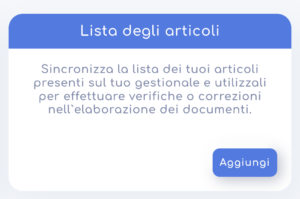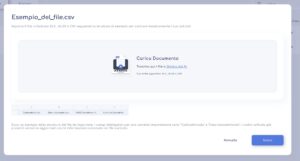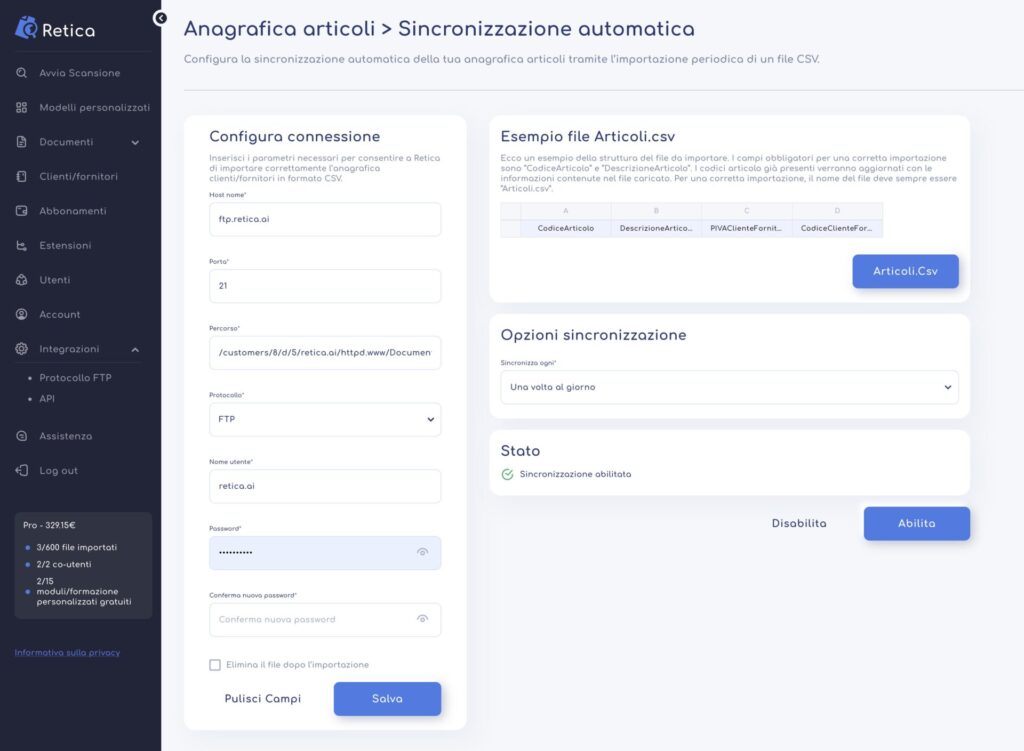List of items
designed to allow the uploading of inventory items, including code and description. This feature allows these items to be used to verify information obtained from document scans.
Let’s see how it works.
Create a list of items
To get started, it is essential to go to the “Extensions” section, press the “Add Extension” button, and then add the “Article List” extension to your active extensions:

Once added, it will be visible among the active extensions.
To begin the configuration, press the “Options” button of the extension and select “About”.

Once inside the section dedicated to the list of articles, to be able to insert the list of your articles you need to press the gear-shaped button and select “Add”.

Next, select “Add manually” from the window that appears and enter the data needed to create an item. The mandatory information is: Item Code and Description. Choosing the customer/supplier associated with the item is optional; however, if selected, the item will be associated with it and will be visible within the customers/suppliers section.
If you want to import one or more items in bulk, you can do so via an XLS, XLSX or CSV file. To proceed, follow the steps explained above, but instead of pressing the “Add manually” button, select “Import via CSV file”. Once pressed, a window will appear where you can import the file by dragging it into the gray area. The file must contain four columns: ItemCode, ItemDescription, PIVACementeSupplier, CodiceClienteSupplier.
Make sure to leave the column headers in the first row of the file. For import via file, the necessary information is: ItemCode and ItemDescription. If you want to link the item to a customer or supplier, you must also fill in the PIVAClienteFornitore or the CodiceClienteFornitore, based on the information available for that customer/supplier. Finally, press the “Save” button to massively upload your customer details.

If you want to automatically synchronize the articles with your business software, follow these steps:
- Open Settings:
Press the wheel button to open the settings.
Select “Sync. Automatic”. - Connection Configuration:
On the page that opens, locate the “Configure connection” block.
This block allows you to configure the FTP, FTPS or SFTP connection with your server.
Enter all the required parameters and press the “Save” button.
If the connection is established correctly, a green badge will appear to confirm the successful connection.
In case of problems, a red warning will appear to indicate the error encountered.
Once successfully established, the configuration is automatically saved. - CSV File Structure:
The “Example anagraphics” block shows the correct structure that the CSV file must have to be read correctly.
Using the “Articles.csv” button you can download an example of the CSV file to use.
Make sure that the CSV file created and stored in the FTP folder has the name “Items.csv” and that it contains the mandatory fields for each customer/supplier: “ItemCode” and “ItemDescription”. - Configuration Options:
Go to the “Configuration Options” block.
Here you can select the desired synchronization period - Synchronization Activation:
Press the “Enable” button to activate the synchronization. - Status Monitoring:
In the “Status” block you can see if the synchronization is active and working, view the last synchronization and, in case of errors, the problem that is blocking the synchronization will be shown.
Important Note:
Synchronization does not occur in real time, but at the beginning of the following day. To monitor the synchronization status, keep an eye on the “Status” block.

List of items
Once the selected items have been added, they will be visible in the main table of the section, along with their associated data:

By pressing the options button at the end of a customer or supplier line, you can perform the following actions:
- Edit: Modify the customer/supplier information via a dedicated window.
- Remove: Permanently delete the customer/supplier.
Enabling processes
Once you have added the desired items, you can go to the “Processes” subcategory and enable the switch to activate the automatic process “Auto-completion of data detected in documents”. This process allows you to automatically add the item code to the output file when, during the processing of a document, only the description of an item is found. If this description matches that of one of the items in the imported list, Retica automatically adds the item code.
For more information, you can press the “Options” button and select the “Information” item.




